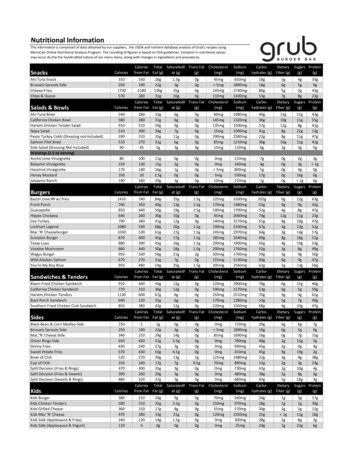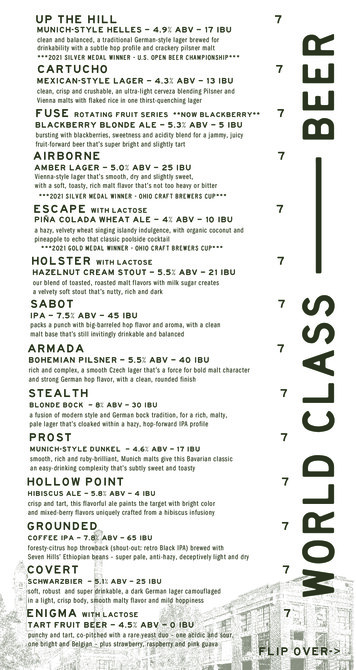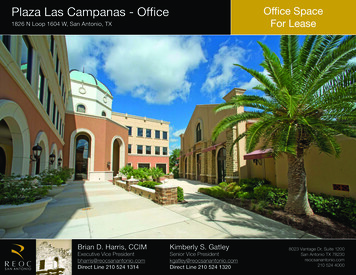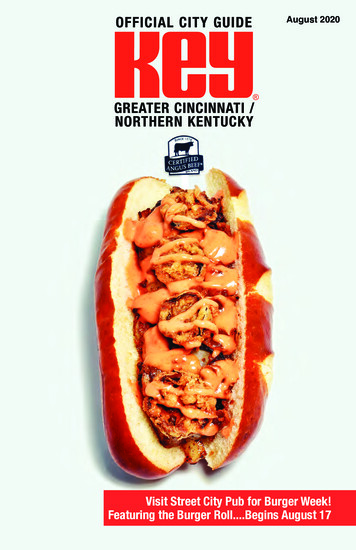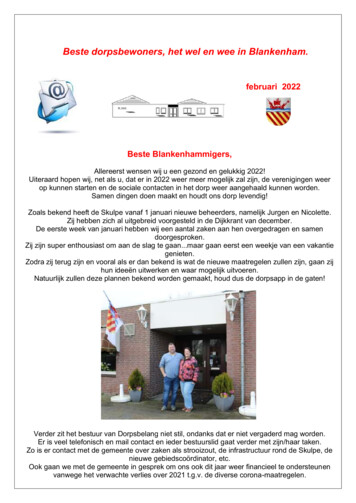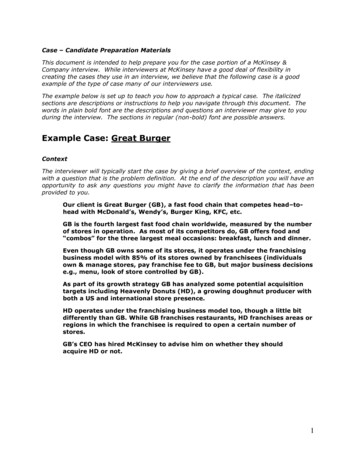
Transcription
Case – Candidate Preparation MaterialsThis document is intended to help prepare you for the case portion of a McKinsey &Company interview. While interviewers at McKinsey have a good deal of flexibility increating the cases they use in an interview, we believe that the following case is a goodexample of the type of case many of our interviewers use.The example below is set up to teach you how to approach a typical case. The italicizedsections are descriptions or instructions to help you navigate through this document. Thewords in plain bold font are the descriptions and questions an interviewer may give to youduring the interview. The sections in regular (non-bold) font are possible answers.Example Case: Great BurgerContextThe interviewer will typically start the case by giving a brief overview of the context, endingwith a question that is the problem definition. At the end of the description you will have anopportunity to ask any questions you might have to clarify the information that has beenprovided to you.Our client is Great Burger (GB), a fast food chain that competes head–tohead with McDonald’s, Wendy’s, Burger King, KFC, etc.GB is the fourth largest fast food chain worldwide, measured by the numberof stores in operation. As most of its competitors do, GB offers food and“combos” for the three largest meal occasions: breakfast, lunch and dinner.Even though GB owns some of its stores, it operates under the franchisingbusiness model with 85% of its stores owned by franchisees (individualsown & manage stores, pay franchise fee to GB, but major business decisionse.g., menu, look of store controlled by GB).As part of its growth strategy GB has analyzed some potential acquisitiontargets including Heavenly Donuts (HD), a growing doughnut producer withboth a US and international store presence.HD operates under the franchising business model too, though a little bitdifferently than GB. While GB franchises restaurants, HD franchises areas orregions in which the franchisee is required to open a certain number ofstores.GB’s CEO has hired McKinsey to advise him on whether they shouldacquire HD or not.1
QuestionsIn most McKinsey & Company cases the interviewer will guide you through the case with aseries of questions that will allow you to display a full range of problem solving skills. Belowis a series of questions and potential answers that will give you an idea of what a typicalcase discussion might be like.Question 1. What areas would you want to explore to determine whether GBshould acquire HD?A good answer would include the following:There are a number of things I would want to look at here:– I would want to consider what the value of Heavenly Donuts would be to GreatBurger.– I would also want to look at the strategic fit of the companies. Do theycomplement each other? Can they achieve further benefits (or synergies) fromcombining their operations?A very good answer might also include the following:– I would want to look at the cultural similarities/differences, to see if themanagement/employees of the companies would fit in well together– I would like to have a sense of how well positioned GB is to execute a merger withanother company. Have they done this before, for example.You may choose to dive deeper into some of these issues, of yourinterviewer may ask you to do this, for example:To understand the value of HD to GB, I would want to look at a number ofthings– Growth in market for doughnuts– HD’s past and projected future sales growth (break down into growth in numberof stores, and growth in same store sales)– Competition – are there any other major national chains that are doing betterthan HD in terms of growth/profit. What does this imply for future growth?– Profitability/profit margin– Investment required to fund growth (capital investment to open new stores,working capital)2
Question 2. The team started thinking about potential synergies that couldbe achieved by acquiring HDHere are some key facts on GB and HD.Stores TotalGBHD5,0001,020–North er100010%15%GBHD Total store sales 5,500M 700M Parent company revenues 1,900M 200M Annual growth in storesFinancials Key expenses (% sales)–Cost of sales*51%40%–Restaurant operating costs24%26%–Restaurant property & equipmentcostsCorporate general & administrativecosts4.6%8.5%8%15%6.3%4.9%– Profit as % of sales Sales/store 1.1M 0.7M Industry average 0.9M 0.8M*Variable costs, mostly food costsWhat potential synergies can you think of between GB and HD? Foryour information, a synergy is an area where additional benefitscan be captured over and above the sum of the two companies(such as cost savings or additional revenue).3
A good answer would include the following:There appear to be opportunities in cost savings and in revenue gains.In cost savings:– There may be an opportunity to save on General & Administrative Expensesthrough combining management locations/functions– There may be decreased Cost of Sales (per unit) because the companies arepurchasing greater volumes togetherIn revenues:– Additional sales can be achieved through selling Donuts in GB stores– Also GB have a greater global presence which HD could leverage in order to growoutside the USA very good answer might also include the following:– GB appear to manage their property and equipment costs better, which meansthat they may be able to transfer this skill to HD– Since GB has greater Sales per Store, they may have better skills in finding goodlocations for stores, and could transfer this skill to HD– Since GB is bigger, it probably has more investment capital available to help HDgrow at a more rapid rate.Question 3. The team thinks that, with synergies, it should be possible todouble HD’s US market share in the next 5 years, and that GB’s access tocapital will allow it to expand number HD of stores by 2.5 times. What salesper store will HD require in 5 years in order for GB to achieve these goals?You should assume: Doughnut consumption per head in the US is 10/year today, and isprojected to grow to 20/year in 5 years For ease of calculation, assume US population is 300M Use any data from the earlier table that you needA good answer is as follows:HD will require a sales per store of 1.2M– Today’s market share is 700M/ 3B 25%. This is available from the earliertable, and you are encouraged to make sensible, round estimates in acalculation.– Expected US market in 5 years 20 *300M 6B– If HD double today’s market share, the will have a market share of 50%, sotheir sales will be 50% x 6B 3B– They are also expect to have 2,500 stores ( 2.5 x 1,000)– So sales per store 3B / 2,500 1.2MA very good observation to make is that this seems like a realistic growthtarget, because we are requiring stores sales to less than double, while wealready know that per head consumption of donuts is likely to double.4
Question 4. One of the synergies that the team thinks might havea big potential is the idea of increasing the businesses’ overallprofitability by selling doughnuts in GB stores. How would youassess the impact of this move on overall profitability?A good answer is as follows:I would try to work out the incremental impact this move would have onprofits. To do this I would:– Calculate the incremental revenues we would get from selling donuts in GBstores (how many, at what price, etc)– Calculate the additional incremental costs that would be incurred from doing so(for example, additional staff, additional training, additional marketing,additional distribution and purchasing costs)– I would also look at the additional store investment we would have to make(for example, extra space, new equipment, etc).A good answer would also include:– We should also investigate if the additional donut sales would mean lower sales oftraditional GB products. For example, breakfast products might be affected asmany people have donuts for breakfast. In case you are unfamiliar with theterm, this concept is known as “cannibalization”.Question 5. What would be the incremental profit per store if we think weare going to sell 50,000 doughnuts per store at a price of 2 per doughnut ata 60% margin with a cannibalization rate of 10% of GB’s sales? Note thatthe cannibalization rate is the percentage of GB products which we think willnot be sold because they have been replaced by donut sales. Here is someadditional information which will help you:Current units of GB sold per storeSales price per unitMargin300,000 3 per unit50%A good answer is as follows:There will be 15,000 incremental profit per store:– Donut sales will bring in an additional 60,000 in profit ( 2 price x 50,000 x60% margin)– However, we will lose 45,000 in the original profit from GB sales (10%cannibalization rate x 300,000 products x 3 price x 50% margin).5
Question 6. You run into the CEO of GB in the hall. He asks you tosummarize McKinsey’s perspective so far on whether GB shouldacquire HD. Pretend I am the CEO - What would you say?A good answer would include the following:Early findings lead us to believe acquiring HD would create significant value for GB,and that GB should acquire HD– US Growth targets seem achievable given the expected growth in Donutconsumption in the US– There are other opportunities to capture growth from international expansionof HD– We also believe there are other potential revenue and cost synergies that theteam still needs to quantify.A very good answer might also include the following:– We believe HD can add 15k in additional profit per GB store simply by sellingdonuts in GB stores. This represents a 25% increase in store profit from thismove alone– We will also provide you with recommendations on the price you should payfor HD, as well as any things you need to think about when consideringintegrating the two companies.6
Case – Candidate Preparation MaterialsThis document is intended to help prepare you for the case portion of a McKinsey&Company interview. While interviewers at McKinsey have a good deal of flexibility increating the cases they use in an interview, we believe that the following case is a goodexample of the type of case many of our interviewers use.The example below is set up to teach you how to approach a typical case. The italicizedsections are descriptions or instructions to help you navigate through this document. Thewords in plain bold font are the descriptions and questions an interviewer may give to youduring the interview. The sections in regular (non-bold) font are possible answers.Example Case: Magna HealthContextThe interviewer will typically start the case by giving a brief overview of the context, endingwith a question that is the problem definition. At the end of the description you will have anopportunity to ask any questions you might have to clarify the information that has beenprovided to you.Our client is Magna Health, a health care company in the Midwest.It both insures patients and provides health care services.Employers pay a fixed premium to Magna for each of theiremployees in return for which Magna covers all necessary healthservices of the employee (ranging from physician care, andmedications to hospitalization)Magna currently has 300,000 patients enrolled in its plan. It has300 salaried physician employees who provide a broad range ofservices to patients in 6 centers. These physicians represent awide range of specialty areas, but not all areas. When a patientneeds medical treatment in a specialty area not covered by aMagna physician, they are referred outside of the Magna networkfor care, and Magna pays all referral costs on a fee-for-servicebasis. Magna doesn’t own any hospitals itself, instead contractingservices from several local hospitals.Over the past six months, Magna has been experiencing decliningprofitability.Magna’s CEO has retained McKinsey to helpdetermine what is causing the problem and how Magna might fixit.How can Magna Health improve its financial situation?1
QuestionsIn most McKinsey & Company cases the interviewer will guide you through the case with aseries of questions that will allow you to display a full range of problem solving skills. Belowis a series of questions and potential answers that will give you an idea of what a typicalcase discussion might be like.Question 1. What key areas would you want to explore in order tounderstand Magna’s decline in profitability?A good answer would include the following:I would want to consider Magna’s revenues and costs (variable and fixed).In thinking about Magna’s main cost components – I would want toconsider administrative (or non-medical) and medical costs (e.g. hospital,drugs, outpatient care)A very good answer might also include the following:You may choose to dive deeper into the different costs, for example:Outpatient costs could be further split into internal physician costs versusexternal referral costs.Or you may decide to explore other factors that affect cost, for example:I would also want to understand how Magna’s patient basedemographics/overall risk profile might affect medical costsQuestion 2. After reviewing the basics of Magna’s business, yourteam believes that one of the root causes of Magna’s financialproblems is how it manages medical costs, particularly the cost ofreferrals to specialists outside its physician network.Your team has gathered the following information on Magna and itsprimary competitor, Sunshine HMO:NumberofpatientsAverage cost ofreferral(per member permonth)MagnaHealth300,000 20SunshineHMO500,000 15What are the most likely reasons that the average cost of referralat Magna is higher than at Sunshine? Remember you should feelfree to offer hypotheses and ask questions to clarify thisinformation.2
A good answer would include the following:Referral Pricing. Magna might be paying more than Sunshine for specialistservices (e.g., its outside contracts with oncologists might be at higherrates than Sunshine’s contracts).Number of referrals. Magna’s physicians might have different practicepatterns than Sunshine physicians, i.e. they may be less comfortabletreating heart disease patients or have different training/ protocols.A very good answer might also include the following:Mix of specialties.Magna’s mix of specialties that require referrals(cardiology and neurosurgery) are probably more expensive specialties(than cardiology and psychiatry, Sunshine’s referral specialties).Mix of patients. Magna has sicker or older ( 65) patients (individuals over65 are more likely to need medical care in the specialty areas outside ofMagna’s network, particularly cardiology).Question 3. Magna’s CEO has a hypothesis that Magna is paying toomuch in cardiology referral costs for its patient population. He asksthe McKinsey team to look at Magna’s cardiac patient populationmore closely and tell him how many referrals he should expect onan annual basis. Assume the following:- Magna has 300,000 patients in any one year- 20% of its patients are age 65 or older- In the U.S. patients with serious heart disease visitspecialists (cardiologists) on average 5 times per yearAt this point you should realize that you need to know the difference inprevalence rate (percentage of the population that has a disease at anyone point in time) of serious heart disease in the 65 and over populationand the less than 65 population. When you find that you need additionalinformation or clarification of the information you have received, youshould not hesitate to ask the interviewer. When asked, the interviewerwould provide you with the following data:- The prevalence rate of serious heart disease in the 65 population is 30%- The prevalence rate of serious heart disease in the underage 65 population is 10%3
A good answer is as follows:Magna should expect 210,000 cardiac referrals annually based on itspatient population300,000 total patients20% x 300,000 60,000 patients age 65 60,000 x 30% 18,000 patients age 65 with serious heartdisease18,000 x 5 90,000 referrals per year240,000 Magna patients under the age of 65240,000 patients x 10% 24,000 patients under age 65 withserious heart disease and 24,000 x 5 visits per year 120,000visits per year total90,000 120,000 visits per year 210,000 total Magna patientexternal cardiology visitsQuestion 4. When the team tells Magna’s CEO that based onMagna’s patient population he should expect about 210,000cardiology referrals a year he exclaims, “We currently pay for300,000 annual cardiology referrals for our patient population!”Why might Magna’s annual cardiology referrals be significantlyhigher than U.S. averages?A good answer is as follows:The prevalence rate of heart disease in Magna’s patient population ishigher than averageThe interviewer might ask a follow on question at this point:Why would a physician refer a patient who does not have seriousheart disease to a specialist?A good answer would include the following:Patients are demanding referralsA very good answer might also include the following:Primary care physicians are not comfortable (e.g., they are poorly trainedor inexperienced) treating cardiac patients, even those with minorproblems; they want to avoid malpractice suitsMagna doesn’t have clear guidelines on when physicians should bereferring patients to specialists (or if guidelines exist, physicians are notcomplying with them)There are no incentives or penalties to prevent physicians from referringpatients with less serious problems to specialists.4
Question 5. After some additional investigation, your team thinksthat changing the behavior of Magna’s primary care physicians haspotential to reduce cardiac referral costs while maintaining highquality care.The team believes that introducing some sort ofincentive plan for physicians might help reduce the referral rate:The team’s idea for a pilot plan is to increase overall fees thatMagna pays to primary care physicians to handle more of theirpatients’ basic cardiology needs. Overall fee increases wouldtotal 1million In addition to the team’s proposal, Magna’s Medical Directorwants to pilot the following idea:Magna pays bonuses of 100,000 per year to each of the 10 primary care physicians withthe lowest cardiac referral rates consistent with good patientoutcomes. Although the team mentions to the Medical Director that there areother issues to consider relating to the pilot that are not financial,such as the ethical impact of incentivizing physicians not to referpatients to specialist treatment, he wants the team to do the firstcalculation including both ideas:Part A. How many fewer cardiology referrals will Magna need tohave in order to recoup the cost of the pilot incentive plan(including the team’s and the Medical Director’s ideas)?Forsimplicity’s sake assume:- The cost of a cardiology referral is 200- Magna currently has 300,000 cardiology referrals per yearA good answer is as follows:If the incentive plan reduces cardiology referrals by 3.3% or 10,000referrals, Magna will recoup the cost of the incentive plan. One potentialapproach to the calculation is as follows: 1 million (10 * 100,000) 2 million for incentive plan 2 million/ 200 10,000 referrals10,000 referrals/300,000 total referrals 3.3%reduction would payfor incentive programPart B.Your team projects that the incentive plan has thepotential to reduce referrals by 5% in its first year, and anadditional 2% in its second year. If these projections are correct,how much referral cost could Magna save in total over the first twoyears of the incentive plan?5
A good answer is as follows:Referral costs would be 4.14 million lower in the second year. Over thetwo years Magna would save 7.14 million. One potential approach to thecalculation:Year 1 Savings with Program300,000 total referrals5% reduction in referrals 15,000 referrals15,000 x 200 3.0 million in savings in year 1Year 2 Savings with Program285,000 total referrals2% reduction in referrals 5,700 referrals5,700 x 200 1.14 million in savings 3 1.14 4.14 million in savingsTotal cumulative savings over 2 years Year 1 Year 2 savings 3M 4.14M 7.14MQuestion 6. Your team presents its physician incentive proposal toMagna’s CEO. The CEO, in consultation with his Medical Director,agrees that this is feasible and says that they will definitely pilotthe overall higher fees to primary care physicians to handle moreof the basic cardiology needs and they will think about the ideawith the bonuses again due to the ethical concerns the teamraised.At the end of the meeting the CEO says, “I like the work you’vedone, but even if we did implement the bonus payment it’s notenough to address our current financial situation. Physicians areprofessionals who care deeply about patient care and I thinkthere’s a limit to how much cost we can expect to reduce utilizingfinancial incentives exclusively. Besides cardiac financial incentiveprograms, what other ideas should we consider to reduce the costof Magna’s specialist referrals?”Based on what we have discussed today, and any other ideas youmight have, how would you respond to the CEO?A good answer would include the following:I would pursue additional ways to change physician behavior.Forexample: Provide training on how to treat patients with minor or stablemedical problems Define and clarify medical guidelines for referrals (e.g., establish amedical committee to define the difference between “serious” and“minor” heart disease) Institute peer review committee charged with approving a subset ofreferrals (e.g., those that are considered “high cost,”).6
A very good answer might also include the following:Other ideas outside of changing physician behavior might include: Spend time investigating “outlier” physicians (i.e., those who seemto refer patients to specialists at much higher rates than others) todetermine how widespread the referral problem is and whethersimply focusing on a few physicians will dramatically reduce referralcosts Determine whether Magna can reduce referral costs in the othermedical areas where it does not have specialists (i.e. neurosurgery) Look at the contracts Magna has for specialist services to determineif it is paying too much relative to competitors Consider whether bringing cardiology, neurosurgery, and oncologyspecialists in-house (i.e., within Magna) might reduce cost Educate patients Publicize physician referral rates7
Case – Candidate Preparation MaterialsThis document is intended to help prepare you for the case portion of a McKinsey&Company interview. While interviewers at McKinsey have a good deal of flexibility increating the cases they use in an interview, we believe that the following case is a goodexample of the type of case many of our interviewers use.The example below is set up to teach you how to approach a typical case. Theitalicized sections are descriptions or instructions to help you navigate through thisdocument. The words in plain bold font are the descriptions and questions aninterviewer may give to you during the interview. The sections in regular (non-bold) fontare possible answers.Example Case: Airport TaxiContextThe interviewer will typically start the case by giving a brief overview of the context,ending with a question that is the problem definition. At the end of the description youwill have an opportunity to ask any questions you might have to clarify the informationthat has been provided to you.You are the operator of a taxi in New York City. You have justdropped off a passenger at LaGuardia Airport, which isapproximately 12 miles from Manhattan – the centre of New YorkCity. Taxis queue to pick up passengers at LaGuardia, so youhave two choices – enter the two hour queue for a passenger, orleave the airport empty to go looking for a fare in Manhattan.Which option would you choose (“stay” or “leave”), and howwould you decide?1
QuestionsIn most McKinsey & Company cases the interviewer will guide you through the casewith a series of questions that will allow you to display a full range of problem solvingskills. Below is a series of questions and potential answers that will give you an idea ofwhat a typical case discussion might be like.Question 1: Before getting into the details, what factors would you consider inmaking your decision?A good answer would include several of the following:The profit on the airport fare (“stay” scenario) vs. the profit that could be earned fromother passengers in the same amount of time (“leave” scenario).Stay scenario:- The average length of an airport fare- Costs incurred on the airport fare- What you would do during the waiting timeLeave scenario:- The amount of time you would have to spendsearching for a non-airport fare- The average length of a non-airport tripA very good answer might also include the following:In both scenarios- The difference between the “flag drop” charge (i.e., initial fare) and the run-rate fare- Tips, whether they are higher in-city or in airport trips- Distance, fuel efficiency in city driving versus highway driving, gas price- How close to shift end is the trip (if regulated by law)- Time of the day (rush hour or not)- Car ownership costs- Tolls- Relative risks, like heavy traffic, construction in some highway areas, stops due tospeed or bumper-to-bumper highway accidentsQuestion 2: Let’s look at the two scenarios separately. How would you thinkabout the “stay” scenario?You may find that you need additional information or clarification of the information youhave received. You should not hesitate to ask the interviewer.In this example, when specifically asked, the interviewer would provide you with thefollowing data:2
Time: Time in queue is 2 hours – learned from experience. Time from the airport toManhattan is irrelevant, but it is constant. Average time spent searching for apassenger in Manhattan is 10 minutesFare structure: 4 for the 1st mile or fraction thereof 2 per additional mile orfraction thereofTips: The average passenger pays a tip of approximately 15% of the fareTolls: Passenger pays all tolls (assume there is a 3 toll for any of the bridge/tunneloptions between LaGuardia and Manhattan)Distances: As discussed in case setup, 12 miles from Manhattan to LaGuardia (andvice versa). Assume that airport-Manhattan passenger lives right off of the highway, sotrip is exactly 12 miles. Average trip length downtown is 2 milesSpeed: Average speed from the airport to downtown is irrelevant, but it is constant.Average speed downtown, whether searching for or driving a passenger, is 12 mphCar ownership costs: The cab is leased by the driver from the cab company on avariable cost basis. Driver pays 50% of metered revenue to the cab company with noopportunity to cheat.In this example you make assumptions about the necessary values and use thenumbers above for numerical simplicity.A good answer would include the following:Stay scenario:- Time. Total time incurred would be the wait time (given as two hours) plus theamount of time required to drive to Manhattan with the passenger. As specified in thecase setup, the distance is twelve miles- Metered revenue. The cab’s fare structure is 4 for the first mile of fraction thereof,plus 2 for each additional mile or fraction thereof. There are no charges forstopped/slow traffic, extra passengers or luggage. For this 12 mile trip the meteredrevenue is 26, which is 4 (11x 2)- Tip revenue. At 15%, the tip would be 3.90, so the likely tip would be 4 – bringingtotal revenue to 30A very good answer might also include the following:- Fuel. Assuming the cab, like most cabs, is a fairly large vehicle and be relatively oldwith lots of miles, which means that it would have mediocre fuel efficiency. Fornumerical simplicity, let’s assume 24 MPG highway and 12 MPG city and that gasprices in NYC are approximately 2 per gallon. Because the engine doesn’t run while3
waiting in the queue, the cost of fuel for this trip is 12 highway miles / 24 MPG x 2 pergallon 1- Car ownership costs. The cab driver leases the cab from the cab company on avariable cost basis. He must pay the cab company 50% of metered revenue, and thereis no opportunity to cheat. For this trip, he would pay 13- Tolls. Customer pays the 3 so this has no impact on the driver. (If the passengertips on the toll, it could increase the driver’s tip revenue by 50 cents)Question 3: How would you think about the other scenario, where you leave theairport empty and go looking for passengers in Manhattan?A good answer would include the following:Leave scenario:- Empty time. Empty time would be the travel time trip to Manhattan. As specified inthe case setup, the distance from the airport to downtown is twelve miles. It will dependon traffic also.- Search time. Once reaching Manhattan, there is no guarantee that the driver wouldfind a passenger immediatelyA very good answer would include the following:- Trip distance. Assuming the average (and vast majority) of trips originating inManhattan are to other destinations in Manhattan, therefore will be an intra-Manhattantrip, probably less than 2 miles- Revenue. For each intra-Manhattan trip, the metered revenue would be 6 ( 4 forthe first mile and 2 for the second mile). A 15% tip would be .90, so the passenger islikely to tip 1, bringing total revenue per intra-Manhattan trip to 7- Fuel. Assuming the cab, like most cabs, is a fairly large vehicle and be relatively oldwith lots of miles, which means that it would have mediocre fuel efficiency. Fornumerical simplicity, let’s assume 24 MPG highway and 12 MPG city and that gasprices in NYC are approximately 2 per gallon. The cost of fuel to drive downtownempty is 12 highway miles / 24 MPG x 2 per gallon 1. The cost of fuel for drivingaround Manhattan is 2 per hour, because all downtown driving is at an average of 12mph. This equates to .66 per trip assuming 10 minutes of searching and 10 minutes ofdriving for each trip-
Case - Candidate Preparation Materials This document is intended to help prepare you for the case portion of a McKinsey & Company interview. While interviewers at McKinsey have a good deal of flexibility in creating the cases they use in an interview, we believe that the following case is a good

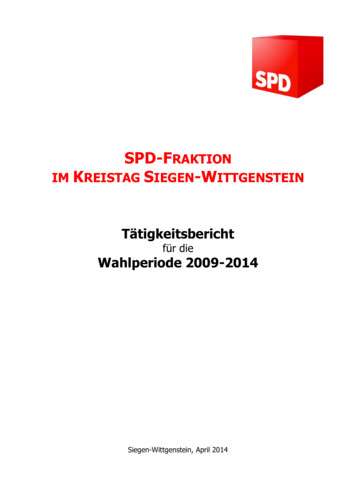
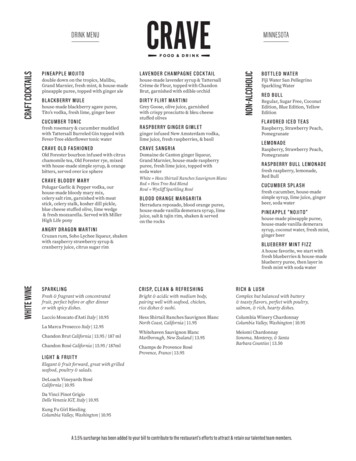
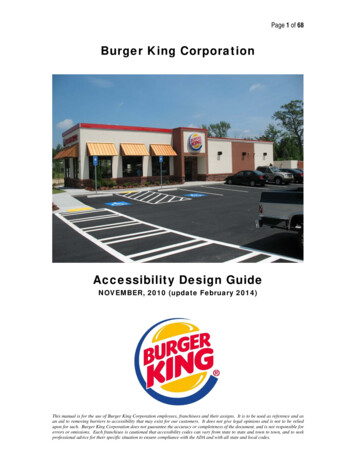
![[EPUB ] The Bob's Burgers Burger Book: Real .](/img/6/the-bob-039-s-burgers-burger-book-real-recipes-for-joke-burgers.jpg)
